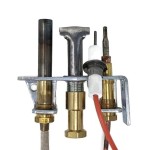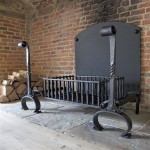Ash Can for Fireplace: Functionality, Selection, and Maintenance
The proper management of fireplace ash is crucial for both safety and efficiency. Accumulated ash can pose a fire hazard if not properly handled, and it can also impede the optimal performance of the fireplace. An ash can, specifically designed for fireplace use, provides a safe and effective method for removing and storing ashes. This article will explore the functionality of ash cans, factors to consider when selecting one, and recommended maintenance practices to ensure longevity and safe operation.
Ash cans are typically constructed from durable, heat-resistant materials such as galvanized steel or aluminum. These materials are chosen for their ability to withstand the high temperatures of residual embers that may be present in fireplace ash. The design of an ash can typically includes a tight-fitting lid to prevent ash dust from escaping and potentially causing respiratory irritation or creating a mess. Many models also feature a carry handle for ease of transportation and disposal.
The primary function of an ash can is to provide a contained environment for cooling and storing fireplace ash. Direct disposal of hot ash into a trash can or outdoor environment can present a significant fire risk. The ash can allows embers to extinguish completely while preventing the spread of ash dust. This controlled environment minimizes the potential for accidental fires and contributes to a safer home environment.
Key Considerations for Selecting an Ash Can
Choosing the appropriate ash can involves considering several factors to ensure it meets specific needs and safety requirements. Key considerations include size, material, lid design, and overall construction quality. Each of these factors contributes to the functionality and lifespan of the ash can.
Size and Capacity: The size of the ash can should be commensurate with the frequency of fireplace use and the volume of ash generated. A larger fireplace that is used frequently will require a larger ash can to accommodate the accumulation of ash. Conversely, a smaller fireplace used less often may only require a smaller capacity ash can. Overfilling an ash can can compromise its safety and effectiveness, making it essential to choose a size that suits the user’s needs. Furthermore, consider the physical space available for storing the ash can, as this will also influence the appropriate size selection.
Material and Heat Resistance: The material of the ash can is paramount in ensuring its ability to withstand the high temperatures associated with fireplace ash. Galvanized steel and aluminum are common choices due to their inherent heat resistance and durability. Thicker gauge metal provides increased protection against heat and prevents warping or deformation. Certain ash cans may feature additional heat shields or insulating layers for enhanced safety. Consider the maximum temperature rating of the ash can to ensure it is suitable for the intended use.
Lid Design and Seal: A tightly sealing lid is crucial for preventing the escape of ash dust and minimizing the risk of embers reigniting. The lid should fit securely and create an airtight seal to contain the ash effectively. Some lids feature locking mechanisms or clamps to ensure a tight closure, even if the can is accidentally tipped or moved. Consider the ease of opening and closing the lid, as frequent access is required for ash removal. A well-designed lid significantly contributes to the overall safety and cleanliness of the ash can.
Safe Ash Removal and Handling Procedures
Proper ash removal and handling are essential for preventing fires and minimizing the risk of respiratory irritation. Following a well-defined procedure ensures that ashes are handled safely and efficiently. This procedure includes allowing adequate cooling time, using appropriate tools, and disposing of ashes responsibly.
Cooling Period: Before removing ashes from the fireplace, it is imperative to allow them to cool completely. This cooling period can range from 24 to 48 hours, depending on the size of the fire and the amount of remaining embers. Rushing the cooling process can lead to the inadvertent transfer of hot embers into the ash can, posing a significant fire hazard. To ensure complete cooling, visually inspect the ash for any signs of remaining embers before proceeding with removal.
Ash Removal Tools: Utilize tools specifically designed for ash removal, such as a shovel and a metal container with a lid. Avoid using plastic tools or containers, as they are not heat-resistant and can melt or ignite. Gently scoop the ash into the metal container, being careful not to stir up excessive dust. Consider using a fine mesh screen to sift out any larger pieces of unburned wood, which can be reused in future fires. A dedicated ash shovel and container will streamline the removal process and minimize the risk of spills or accidents.
Safe Disposal Practices: Once the ash has cooled completely and is safely contained in the ash can, it can be disposed of properly. Never dispose of ash directly into a trash can, compost pile, or against any combustible materials. The ideal disposal method is to bag the ash in a plastic bag, seal it tightly, and place it in a non-combustible container away from the house or any other flammable materials. Contact local waste management services for specific guidelines on ash disposal in the area. Another option is to spread the cold ash thinly in a garden, as wood ash can act as a soil amendment. However, exercise caution if the soil is alkaline as wood ash can raise the pH level further.
Maintaining the Longevity of the Ash Can
Proper maintenance of the ash can will extend its lifespan and ensure its continued safe operation. Regular cleaning, inspection, and storage practices are essential for preventing corrosion, ensuring proper lid function, and maximizing the can's overall effectiveness.
Regular Cleaning: Periodically clean the ash can to remove accumulated ash residue and prevent corrosion. After emptying the can, use a brush or cloth to remove any remaining ash particles. Avoid using water to clean the ash can, as moisture can promote rust and corrosion, especially in galvanized steel models. If necessary, use a damp cloth to wipe the interior and exterior surfaces, ensuring that the can is completely dry before storing it. Regular cleaning will help maintain the can's appearance and prevent the buildup of debris.
Lid Inspection and Maintenance: Inspect the lid regularly to ensure it fits tightly and functions properly. Over time, the lid can become bent, warped, or corroded, compromising its ability to create an airtight seal. If the lid is damaged, replace it immediately to prevent ash dust from escaping. Use a wire brush to remove any rust or corrosion on the lid or the rim of the can. Applying a thin layer of heat-resistant lubricant to the lid's hinges or locking mechanism can help maintain smooth operation and prevent sticking. A well-maintained lid is crucial for the safety and effectiveness of the ash can.
Proper Storage: Store the ash can in a dry, sheltered location when not in use. Exposure to moisture and the elements can accelerate corrosion and reduce the can's lifespan. A garage, shed, or covered porch provides ideal storage conditions. Avoid storing the ash can near combustible materials or in areas where it could be easily tipped over. Proper storage will protect the can from damage and ensure it is ready for use when needed.
By understanding the functionality, selection criteria, safe handling procedures, and maintenance practices associated with ash cans, users can effectively manage fireplace ash and minimize the risk of fire hazards. A well-chosen and properly maintained ash can is an essential tool for any homeowner with a fireplace.

Open Hearth Accessories Black Steel Ash Bucket In The Fireplace Department At Com

Pleasant Hearth Ash Can

Amagabeli Ash Bucket With Lid Outdoor And Indoor Coal For Fireplace Small Fire Metal Can Grill Charcoal Essential Tools Pit Wood Burning Stove Broe

Ash Bucket With Lid Shovel And Hand Broom 2 6 Gallon Metal Coal Can For Fireplace Fire Pits Wood Burning Stoves Indoor Outdoor Stove Cleaning Tools

Amagabeli Ash Bucket With Lid Outdoor And Indoor Coal For Fireplace Small Fire Metal Can Grill Charcoal Essential Tools Pit Wood Burning Stove Broe

Ash Can Pail For Fireplace Stove Hot Ashes Black Bucket Rockford Chimney

Pleasant Hearth Black Steel Ash Bucket In The Fireplace Accessories Department At Com

Pleasant Hearth Ash Can

Ash Bucket With Lid Shovel And Hand Broom 5 2 Gallon Metal Coal For Fireplace Fire Pits Wood Burning Stove Can Cleaning Tools

Smedley York White Ash Bucket With Lid Includes A Firepit Shovel An Gallis Hill House








